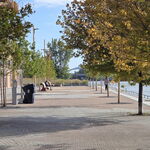We do have a roundabout thread - and here it is.
Personally, the only times I have been (as a pedestrian) hit by a car, or almost hit by a car is at a signalized intersection. At the other extreme, I've never even come close to being hit mid-block on major streets when there are no cars coming.
I'd be interested to see comparisions on the injury rate to pedestrians at roundabouts compared to controlled intersections. And on the severity of injuries We can offer our opinions and ancedotes - but the hard numbers would be interesting.
I have to say, I think right turns on reds are the most dangerous as a pedestrian, followed by unprotected left turns (with drivers focused intensely on oncoming traffic and paying no heed to pedestrians). In a roundabout, the deconflicted car traffic allows drivers to focus more on pedestrian conflicts. I think the key design factor is to design roundabouts more as 90 degree turns and not tangents that encourage high approach and exit speeds.
For at-intersection pedestrian-automobile collisions where the pedestrian has right of way that result in KSI, over 2014-2023:
Per year averages are 6.6 straight thru, 25.1 left-turn, and 8.5 right-turn.
402 people hit over that 10 year period broken down by injury:
Major: 318
Fatal: 65
Minor: 12
None: 4
Minimal: 3
Unfortunately, public Toronto Police Service data is poorly structured and lacks key details that prevents good analysis beyond collisions that result in serious injury or fatality. On the one hand, the Pedestrian KSI (Killed or Seriously Injured) data includes injury type, manoeuvre, if speed was involved, road conditions, cursory breakdown of each party involved, plus others.
While TPS' Traffic Collisions data covers
all collisions, it lacks all those properties above, and only contains one record per collision, so it’s impossible to determine the number of people involved (e.g.,
a pedestrian—just one?
a car—two?, or one turning and not paying attention?). Even with coordinates available for each collision which you could filter down to only ones at intersections, you still couldn't say if a car mounted a sidewalk, turned into someone, etc.
According to Pedestrian KSI data, in 2023 159 people were hit in 148 collisions. Injuries: 29 fatal, 119 major, 6 minor, 2 minimal, 3 none.
Of those 159, 73 people were hit while crossing at an intersection, 51 with right-of-way, 22 without right-of-way. I'm curious whether the hand flashing/when you started across plays into how it's categorized...
The minimal/no injuries are in the data because another person (often pedestrian) was more seriously injured in the collision, but all parties are listed in the data including drivers and passengers.
Overall in 2023, Traffic Collisions data shows there were 1,388 pedestrian and automobile collisions—1,082 of those with an injury, 306 without (totally unclear who was injured.. pedestrian? driver? passenger?). An additional 59 pedestrian-involved collisions lack being marked with an automobile involved but are categorized fail-to-remain, and 67 more had no car, motorcycle, or bicycle, with 33 listed as no injury and 34 as injury collisions. Some of these instances can be found in news articles using date and location, like one where a drunk F150 driver killed a pedestrian, but the data doesn't properly list a truck or any vehicle being involved. All this to say some of the data from TPS is a shameful shit-show that would be criticized even if done for a college class assignment.
And for some broader context, there were 66,863 automobile collisions in 2023, down from 81,076 in 2019, but up from 58,603 in 2022.
I think there's an argument to be made that relying on KSI data for pedestrian safety can be misleading, overlooking the broader picture of road safety. Collisions that aren’t classified as KSI may still indicate unsafe conditions, yet they’re swept under the rug as status quo because they didn't significantly alter someone's life, and they don't get included in reports and headlines. This skews decision-making, ignoring the impact of near misses, insurance or vehicle repairs stresses, and potential trauma — whether as a pedestrian or driver.





